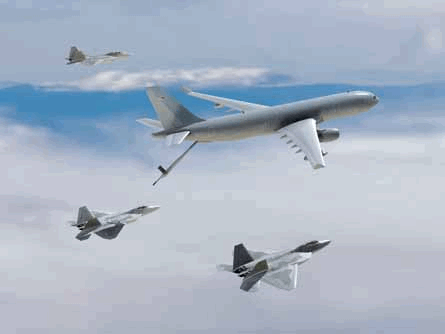The US Department of Defense will reopen the competition for the KC-X contract with two major changes to the evaluation criteria that are already being challenged by Boeing supporters in Congress.
The Pentagon's controversial changes will assign rankings to the 808 individual requirements in the contract solicitation - with a special focus on downplaying the value of life-cycle cost estimates for maintenance and fuel -- and clarify the US Air Force's desire for greater fuel off-load capacity than now provided by the ageing KC-135E fleet.
Both changes would do nothing to undercut the premise of the USAF's original decision to award the contract to the Northrop Grumman/EADS North America KC-30B, a larger aircraft than the Boeing KC-767. USAF officials credited the KC-30B's larger size as a prime factor in their decision.
 |
|---|
That contract award was essentially overturned in June after a review by the US Government Accountability Office (GAO), which found "substantial" errors in the USAF's analysis.
The DoD wants to select a new contractor by December, but the schedule could easily be disrupted. Either competitor has the right to file a new protest with the GAO once the DoD formally releases an amended draft of the request for proposals in late July or early August.
"You know what's going to happen. There's going to be another protest. And we won't get anything done," said Norm Dicks, a Seattle-area Democrat and a staunch Boeing ally, fuming during a House armed services subcommittee hearing on the tanker on 10 July.
Dicks joined other Boeing supporters on the panel who argued against the DoD's new acquisition strategy unveiled the day before by defence secretary Bob Gates.
As the new source selection authority, John Young, undersecretary of defence for acquisition, technology and logistics, inherits the discredited management of a $35 billion acquisition programme stamped with a political bulls-eye in an election year.
Young has outlined a new acquisition strategy that is "grounded" in the USAF's original requirements and solicitation documents. Under Young's plan, changes will be made only where needed to correct evaluation errors identified by the GAO.
The first area involves assigning relative weights to the long list of contract requirements. In particular, Young believes the DoD should assign different levels of importance to various types of costs. Development and production cost estimates will be weighted higher than long-term projections for maintenance and fuel costs, he says.
Such a change appears to offer no advantage to Boeing. The GAO reversed the USAF's determination that Northrop offered the low-cost bid, largely by correcting "errors" in the USAF's calculation of life-cycle cost estimates, which include spares and fuel costs for the next 25 years. Now, Northrop may again assume the cost advantage unless Boeing modifies its bid.
Secondly, Young wants to give the offerors official credit in the new competition for providing greater fuel offload capacity than the KC-135E, while balancing the need to limit technical risks and keep costs low.
Unless Boeing offers a different aircraft, Northrop's larger KC-30B should win the most credit by providing the most fuel offload capacity compared with the KC-767. Boeing has the option of switching to the even larger KC-777, but that could dramatically raise the costs and risks of its proposal.
Both competitors have expressed a willingness to compete again, but Boeing's supporters in Congress are alarmed that the new acquisition strategy will again prove to be unfair.
"The air is charged around this competition. The congress is watching it very closely," Young says. "I have to do the best I can to start a process that could lead to a source selection. I may not make the end of the year but I will make every effort to do that."
Source: Flight International
















